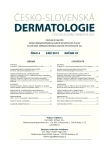Allergic Reaction to Contact with Toxicodendron radicans
Authors:
A. Kováčiková Curková; O. Žilínek; B. Benová; M. Šimaljaková
Authors‘ workplace:
Dermatovenerologická klinika LF UK a UN Bratislava, Slovenská republika
prednostka kliniky prof. MUDr. Mária Šimaljaková, PhD.
Published in:
Čes-slov Derm, 87, 2012, No. 4, p. 145-148
Category:
Case Reports
Overview
Toxicodendron radicans (“Poison ivy”) is a common poisonous plant. It is found, especially, in North America, including the maritime provinces of Canada. It grows well in areas in wet marshlands and river catchment areas. Poison ivy is well known for its production of an irritating substance, an oily resin called urushiol – a mixture of pentadecylcatechols. Urushiol is very sticky and easily attaches to the skin, clothing, tools, equipment or pet’s fur when touching the plant. Poison ivy contact dermatitis develops with itchy rash, blisters, reactions can progress to anaphylaxis. We report the case of a 27-year-old male with urushiol-induced contact dermatitis with impetiginization. He returned from Washington in The United States of America, where he did wild water kayaking. Authors want to highlight the role of dermatologists in detecting this unusual sensitizer occurring in imported cases in our countries.
Key words:
poison ivy – toxicodendron radicans – allergic contact dermatitis.
Sources
1. BALDWIN, R. W., CLEGG, J. A., CURRAN, A. C.: Regulation of the contact sensitivity response to urushiol with anti-urushiol monoclonal antibody ALG 991. Arch. Dermatol. Res., 1999, 291, p. 652–658.
2. EPSTEIN, W. L.: The poison ivy picker of Penny pack Park: the continuing saga of poisonivy. J. Incest. Dermatol., 1987, 88, 3, p. 711.
3. GLADMAN, A. C.: Toxicodendron Dermatitis: Poison Ivy, Oak and Sumac. Wilderness Environ. Med., 2006, 17, 2, p. 120–128.
4. http://www.aad.org/skin-conditions/dermatology-a-to-z/poison-ivy.
5. http://www.mayoclinic.com/health/poison-ivy/DS00774.
6. IVYS, T., TEPPER, R.: Failure of a tappe ring dose of oral methylprednisolone to treat reactions to poison ivy. JAMA, 1991, 266, 10, p. 1362.
7. JUCKETT, G.: Plantdermatitis – possible culprits go far beyond poison ivy. Postgrad. Med., 1996, 100, 3, p. 159–163.
8. KLIGMAN, A. M.: Cashewnut shell oil hyposenzitization against Rhusdermatitis. Arch. Dermatol., 1958, 78, p. 359–363.
9. LEE, N. P., ARRIOLA, E. R.: Poison ivy, oak, and sumac dermatitis. West. J. Med., 1999, 171, 5-6, p. 354–355.
10. PARISER, D. M., CEILLEY, R. I., LEFKOVITS, A. M., KATZ, B. E., PALLER, A. S.: Poisonivy, oak and sumac. Derm. Insights, 2003, 4, 1, p. 26–28.
11. WERCHNIAK, A. E., SCHWARZENBERGER, K.: Poison ivy: an under reported cause of erythema multiforme. J. Am. Acad. Dermatol., 2004, 51, p. 159–160.
12. WILLIFORD, P., SHERERTZ, E.: Poisonivy dermatitis. Arch. Intern. Med., 1994, 3, 2, p. 184–188.
13. ZHAI, H., MAIBACH, H. I., WILHELM, K. P.: Marzulli and Maibach’s Dermatotoxicology. 7th ed. CRC Press Taylor & Francis Group, Boca Raton, 2008, p. 205–206.
Labels
Dermatology & STDs Paediatric dermatology & STDsArticle was published in
Czech-Slovak Dermatology

2012 Issue 4
Most read in this issue
- Differential Diagnostics of Pruritus
- Allergic Reaction to Contact with Toxicodendron radicans
- Subacute Cutaneous Lupus Erythematosus Induced by Spironolactone
- Anogenital Lichen Sclerosus et Atrophicus in Children: Retrospective Analysis of Patients from the Years 2006–2010
